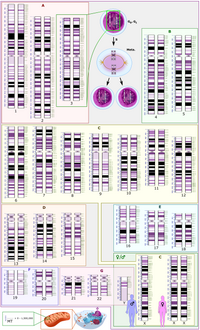
Diagnostic Yield and Novel Candidate Genes by Exome Sequencing in 152 Consanguineous Families With Neurodevelopmental Disorders
Sign Up to like & getrecommendations! Published in 2017 at "JAMA Psychiatry"
DOI: 10.1001/jamapsychiatry.2016.3798
Abstract: Importance Autosomal recessive inherited neurodevelopmental disorders are highly heterogeneous, and many, possibly most, of the disease genes are still unknown. Objectives To promote the identification of disease genes through confirmation of previously described genes and… read more here.
Keywords: exome sequencing; 152 consanguineous; diagnostic yield; consanguineous families ... See more keywords

Parental Leave in Cardiovascular Disease Training Programs.
Sign Up to like & getrecommendations! Published in 2020 at "Journal of the American College of Cardiology"
DOI: 10.1016/j.jacc.2020.05.044
Abstract: Background Intellectual disability (ID) is a common neurodevelopmental disorder affecting 1–3% of the general population. Mutations in more than 10% of all human genes are considered to be involved in this disorder, although the majority… read more here.
Keywords: parental leave; non consanguineous; consanguineous families; disease training ... See more keywords

Loss of Function Variants in the XPC Causes Severe Xeroderma Pigmentosum in Three Large Consanguineous Families.
Sign Up to like & getrecommendations! Published in 2021 at "Klinische Padiatrie"
DOI: 10.1055/a-1552-3788
Abstract: BACKGROUND Xeroderma pigmentosum (XP) is a rare recessively inherited disorder that presents clinical and genetic heterogeneity. Mutations in eight genes, of which seven are involved in nucleotide excision repair (NER) pathway have been reported to… read more here.
Keywords: large consanguineous; three large; xpc gene; xeroderma pigmentosum ... See more keywords

When to think outside the autozygome: Best practices for exome sequencing in “consanguineous” families
Sign Up to like & getrecommendations! Published in 2020 at "Clinical Genetics"
DOI: 10.1111/cge.13736
Abstract: Exome sequencing (ES) is an effective diagnostic tool with a high yield in consanguineous families. However, how diagnostic yield and mode of inheritance relate to family structure has not been well delineated. We reviewed ES… read more here.
Keywords: exome sequencing; consanguinity; outside autozygome; think outside ... See more keywords

Sequence variants in nine different genes underlying rare skin disorders in 10 consanguineous families
Sign Up to like & getrecommendations! Published in 2017 at "International Journal of Dermatology"
DOI: 10.1111/ijd.13778
Abstract: Genodermatoses represent genetic anomalies of skin tissues including hair follicles, sebaceous glands, eccrine glands, nails, and teeth. Ten consanguineous families segregating various genodermatosis phenotypes were investigated in the present study. read more here.
Keywords: variants nine; genes underlying; nine different; sequence variants ... See more keywords

Consanguinity-based analysis of exome sequencing yields likely genetic causes in patients with inherited retinal dystrophy
Sign Up to like & getrecommendations! Published in 2021 at "Orphanet Journal of Rare Diseases"
DOI: 10.1186/s13023-021-01902-5
Abstract: Background Consanguineous families have a relatively high prevalence of genetic disorders caused by bi-allelic mutations in recessive genes. This study aims to evaluate the effectiveness and efficiency of a consanguinity-based exome sequencing approach to capturing… read more here.
Keywords: exome sequencing; dystrophy; consanguinity based; consanguineous families ... See more keywords

Mutational analysis in sodium-borate cotransporter SLC4A11 in consanguineous families from Punjab, Pakistan
Sign Up to like & getrecommendations! Published in 2022 at "PLoS ONE"
DOI: 10.1371/journal.pone.0273685
Abstract: Aim To identify the molecular basis of Congenital Hereditary Endothelial Dystrophy CHED caused by mutations in SLC4A11, in the consanguineous Pakistani families. Methods A total of 7 consanguineous families affected with Congenital Hereditary Endothelial Dystrophy… read more here.
Keywords: slc4a11 consanguineous; sodium borate; analysis sodium; mutational analysis ... See more keywords

Homozygous variants of EDAR underlying hypohidrotic ectodermal dysplasia in three consanguineous families
Sign Up to like & getrecommendations! Published in 2020 at "European Journal of Dermatology"
DOI: 10.1684/ejd.2020.3844
Abstract: Hypohidrotic ectodermal dysplasia (HED) is a congenital anomaly characterized by hypohydrosis, hypotrichosis and hypodontia. Mutations in at least four genes (EDAR, EDARADD, WNT10A, TRAF6) have been reported to cause both autosomal recessive and autosomal dominant… read more here.
Keywords: three consanguineous; family; consanguineous families; edar ... See more keywords

Novel Mutation in LARP7 in Two Iranian Consanguineous Families with Syndromic Intellectual Disability and Facial Dysmorphism.
Sign Up to like & getrecommendations! Published in 2020 at "Archives of Iranian medicine"
DOI: 10.34172/aim.2020.112
Abstract: BACKGROUND Recently, we have reported mutations in LARP7 gene, leading to neurodevelopmental disorders (NDDs), the most frequent cause of disability in children with a broad phenotype spectrum and diverse genetic landscape. METHODS Here, we present… read more here.
Keywords: intellectual disability; disability; consanguineous families; two iranian ... See more keywords